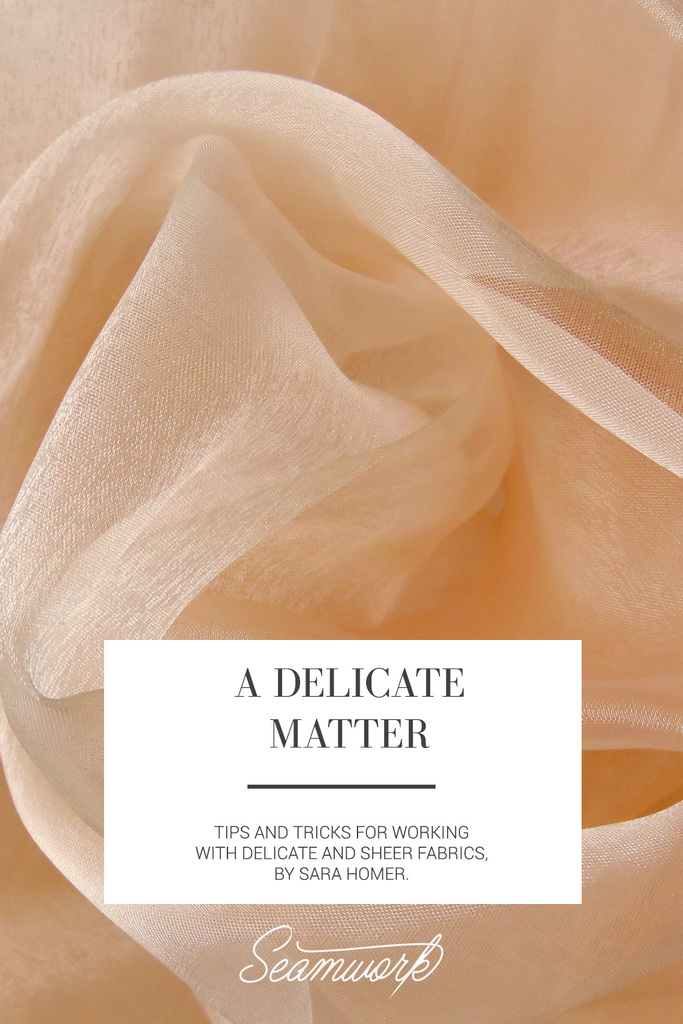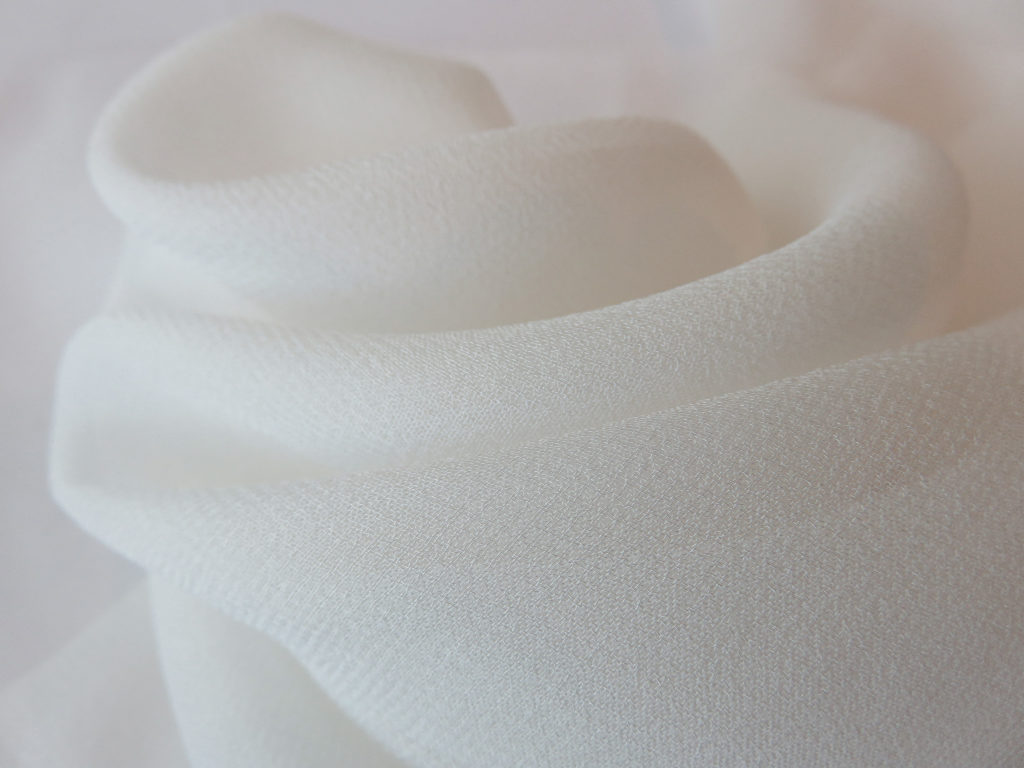
Delicate and sheer fabrics have a magical attraction for many fabric lovers. They can be made into beautiful, feminine garments, yet many of us are wary of them because of the unique challenges they present. While these fabrics do require a considered approach, the good news is that the basic techniques are straightforward and well within the reach of the amateur sewist. Here is a breakdown of the different points in your project where you can incorporate a few small tweaks that will greatly improve the quality of your sewing. You don’t need to be an expert to put these ideas into practice!
Fabric Preparation
Pre-wash carefully. Yes, delicate fabrics should be pre-washed! This may include dry cleaning, if that is the recommendation for your fabric and how you plan to clean your finished garment. In theory, dry cleaning should cause minimal shrinkage. However, it does involve heat. Most high street garments destined for dry cleaning are pre-shrunk before the construction process. If you do machine wash delicate fabrics, use a hand wash cycle to minimize creasing and lay your fabric flat to dry. You can also pop them inside a net bag or pillowcase to prevent threads becoming tangled and fabric becoming stretched or damaged within the drum. Washing may permanently change the surface finish of a fabric, for example some silks are deliberately distressed to create a sand-washed effect.
Stabilizers can be applied at the beginning of garment construction to temporarily change the properties of your fabric, forcing it to act more like well-behaved cotton. These come in wash-, heat-, tear-, and cut-away forms. In this context, the most useful are spray-on starch and wash-away sheet stabilizers. Test your stabilizer on a scrap first, to ensure there will be no lasting damage or residue and that your chosen product will disappear at the wash temperature you plan to use.
Choose Your Tools
Which ingredient, other than bread, will a professional chef use a bread knife to slice? A tomato, because the serrated edge of the bread knife grips the tomato’s smooth skin. An alternative is to use a seriously sharp blade, such as those used by Japanese sushi chefs. These same principles apply to the slippery fabric you would like to cut. Use only the sharpest fabric shears or pinking shears, and consider a set of shears with a serrated edge. This will help you to cut cleanly and accurately, with as little slippage as possible.

Look for the delicates or hand wash setting when pre-washing delicate fabrics.
Standard dressmaking pins are likely to snag or catch threads in your delicate fabric, leading to unsightly pulls that you may not be able to smooth out again. Invest in some fine or ultra-fine pins that are specifically made for silk or lace. These are thin, very sharp, and bendy (and will blunt if you use them on heavier fabrics!), so keep these for special fabrics only. Be sure to pin only within the seam allowances or other unseen areas of pattern pieces, as even the finest pins can leave delicate fabrics with permanent marks.
To combat the tendency of delicate and sheer fabrics to shift unevenly between the presser foot and the feed dogs, consider investing in a specialized presser foot. A relatively inexpensive Teflon foot enables a top layer of fabric to slide more easily under the presser foot, while a slightly more advanced walking foot can help further still, but may cost a bit more.
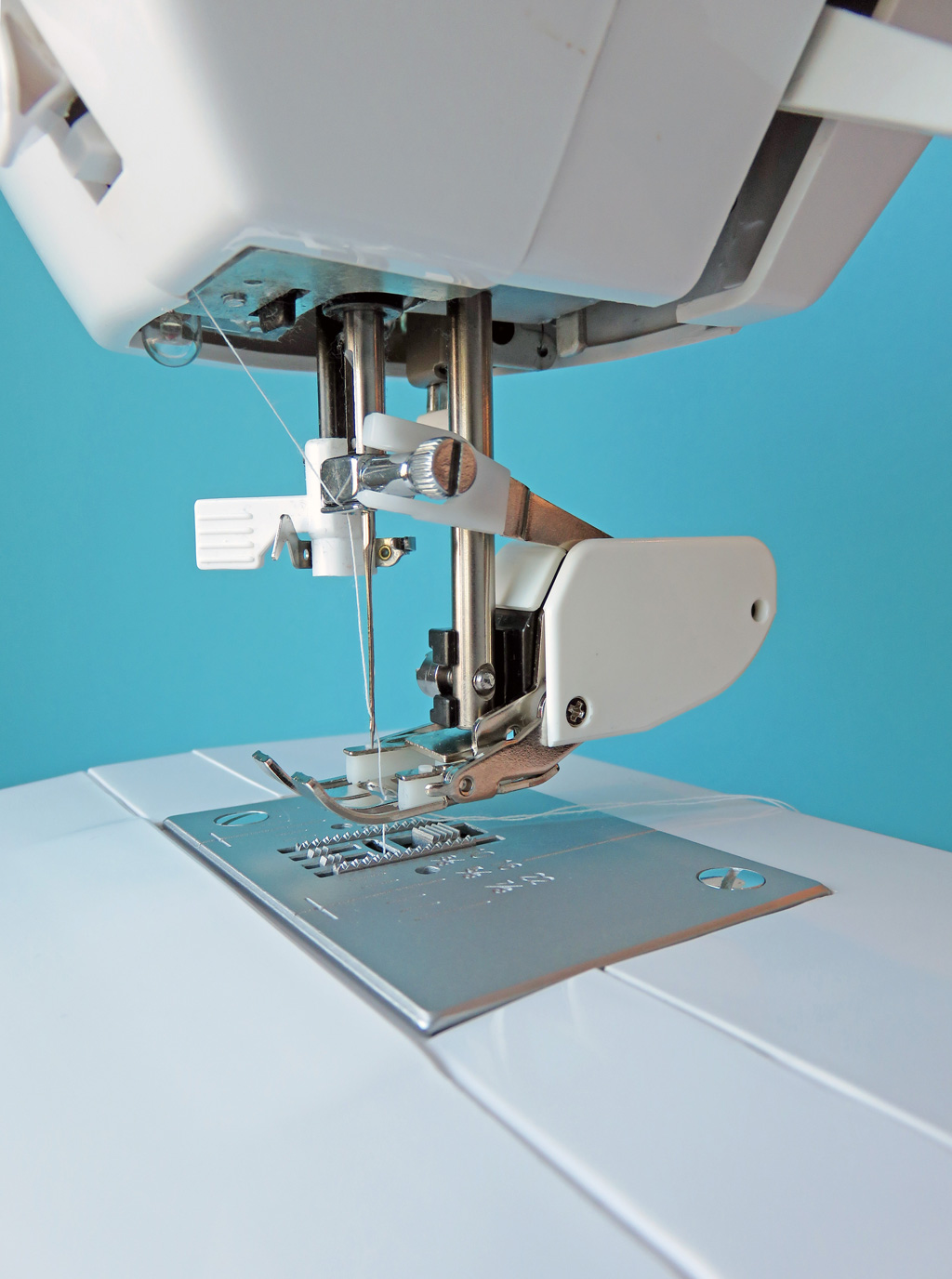
A walking foot has feed dogs that feed the top layer of fabric through at the same rate as the bottom layer, decreasing the tendency for delicate or sheer fabrics to shift and slide.
Finer fabrics also need a fine, sharp needle in your machine in order to minimize snags and pulls. Standard machine needles come in sizes down to an American size 8/European size 60, which can be used for sewing the lightest chiffons. Start you project with a brand new needle and remember to change needles during big projects. The needle should pierce smoothly through the fabric. Any puncture sound as the needle forces itself through the fabric should be taken as a warning that you may need to go down a size further.
A Supporting Cast
Interfacing is often required in the parts of a garment that require structure, and is particularly important in garments made from delicate fabrics and sheers, as these fabrics have little structure, body, or strength of their own. Interfacing can also be used in small strips along seamlines to strengthen the seam. Fusible interfacings are commonly used, and come in a range of weights, quality levels, and prices. Fusible interfacing designed specifically for sheer-weight fabrics is available, and can be really helpful in preventing excessive fraying at your fabric edges. Remember to test it out on a scrap first!
Block fusing, whereby you fuse a large rectangle of fashion fabric prior to tracing or cutting any pieces, can be really helpful with fabrics that would otherwise warp and stretch when handled. Always consider the maximum heat that your delicate fabric can be ironed at. It is also worth considering the openness of the weave of your fashion fabric, as the glue spots on fusible interfacing (particularly lower quality interfacing) tends to have large blobs, which may melt through the weave and leave unsightly, visible glue marks on the right side of your fashion fabric.
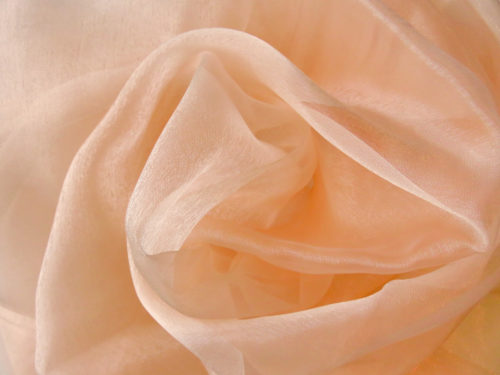
Sew-in interfacing is an option for most sheer and delicate fabrics that is well worth considering. This could be a delicate fashion fabric such as organza or organdy. You can also use self-fabric, which has the benefit of being exactly the right weight and color for the job!
Change Your Look
Underling can change the look or hand of a fabric, and can be helpful if your fashion fabric is too sheer or delicate, if it doesn’t have enough body to match your pattern, or if you want to change the color of your fabric. Note that you can attach facings and hems to the underlining so that the stitches do not show in your fashion fabric. Also, underlining can strengthen the seams of your garment.
Sweater knit tips
Underlining is an excellent way to provide support to fabric, or change the feel of a fabric all together. Learn how to apply this technique to your next project by reading Under Construction: A Guide to Underlining, by Brooks Ann Camper.
To underline a garment, cut all pattern pieces from the delicate fashion fabric, but don’t transfer any markings. Cut a second set of the same pattern pieces from an underlining fabric, usually a tight woven fabric with little stretch such as cotton batiste, silk organza, or cotton muslin. Transfer all markings to the underlining only, then baste the underlining to the fashion fabric. You can also use spray baste, which comes in temporary and permanent types, to hold the two layers together as one piece as you sew. As with fusible interfacing, be wary of the basting glue oozing through open weave fabrics, and always test on a scrap first.
Many sewists making garments from beautiful, delicate silks use a silk thread in a bid to complement the fashion fabric. However, consider the properties of your thread carefully. For example, silk thread is long-lasting but is not as strong as polyester, so it may not always be the best choice.
A Cut Above
Delicate and sheer fabrics can slip and shift significantly when cut, which is one reason sewists find them intimidating to work with. Not only are the fabrics difficult to manage, but grainlines are easily distorted when fabrics shift about in the cutting stage. However, there are several tricks you can use to tame the slippery nature of these fabrics.
Create a grainline guide by squaring up along the crosswise or lengthwise grain, which involves pulling out a weft or warp thread. Grasp a single thread end and start pulling gently, causing the fabric to pucker along the length of the thread. Be patient and careful, and you can pull this thread out along its entire length. This will leave a fine, ghost of a line along a perfect straight grain, which you can then use as a cutting guide. If the effect is too subtle to see easily, you can pull a second thread out.
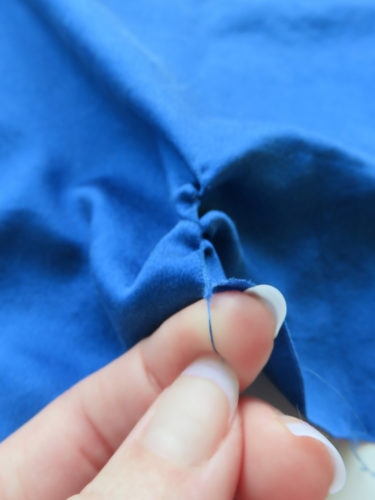
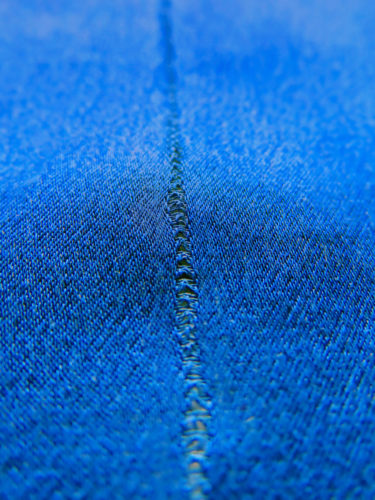
Covering your cutting table with a single large sheet of tissue paper or a clean, ironed sheet to provide grip for delicate fabric and prevent it from sliding around. Paper with a textured finish can be extra helpful in reducing slippage. Cut all pieces in single layers, and consider sandwiching your fabric between two layers of paper. Line up the selvage or straight grain with the edge of the paper, lay the pattern pieces on top of the fabric, then lay another piece of paper on top of the pattern, and pin through all four layers (pattern, paper, fabric, paper) within the seam allowances. Then cut through both paper layers, such that your delicate fabric is sandwiched and less likely to slip. The paper is gripped more easily in the fabric shears than the delicate fabric, producing a more accurate cut.
An alternative is a sharp rotary cutter, which allows you to cut entirely flat, creating less risk of movement and thus less shifting.
Sewing with Delicate Fabrics
Once a delicate fashion fabric has been cut and prepped for sewing, there are several additional points to attend to when constructing your garment.
An Eye on the Edge
Delicate and sheer fabrics tend to fray quickly. Initially, this can be somewhat reduced by pinking the edges with razor-sharp pinking shears. Mark notches with chalk or a hand-stitch, rather than clipping into the seam allowance.
Stay stitching prevents both fraying and stretching, and should not be skipped. It is even possible to stay stitch twice, just within the cutting line on flat fabric before cutting, and then just outside the seam line on each resulting pattern piece.
Fray Check can also be handy if applied to cut edges immediately after cutting. Depending how prone your fabric is to fraying, you may even want to serge all edges immediately, but beware the bulk that this can add, particularly if the edges will be visible through a sheer fabric. Minimizing how much you handle your cut pieces prior to sewing will also decrease the amount of fraying that occurs.
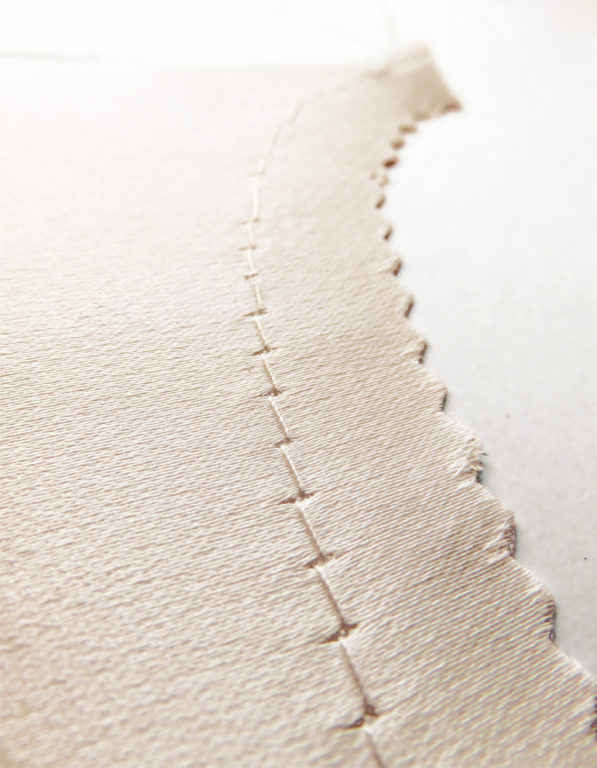
Stitching Considerations
Lightweight and delicate fabrics can pucker or shift when sewn. As mentioned above, a walking foot is one way to deal with this issue; a second method is a straight stitch needle plate with straight stitch foot. A straight stitch needle plate is a specialized needle plate that covers most of the hole between the feed dogs, leaving just enough space for the needle to make a straight stitch in a central position. This provides increased support all around the needle as the stitch is formed, which in turns prevents delicate fabrics from distorting.
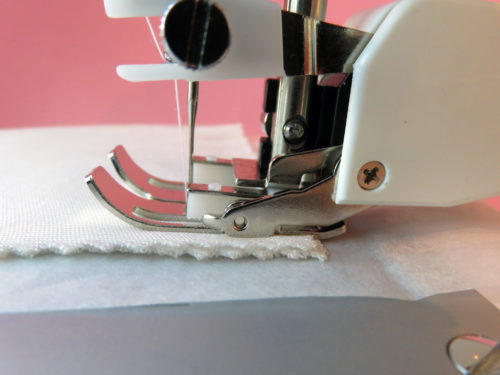
For those who do not wish to invest in new equipment, tissue paper can also be used to prevent delicate fabric from getting sucked between the feed dogs. Simply pin a small strip of tissue paper under the seam line, then rip it off gently afterwards. It will be easier to tear the tissue cleanly if you first fold it back and score it along the stitch-line with a fingernail. Place the tissue an inch or two above the top edge of the fabric to avoid the risk that the fabric bunches up when backstitching at the start of the seam. Alternatively, shorten your stitch at the top and bottom of the seam in lieu of backstitching to secure the stitches.
In general, you will want to shorten your stitch length on fine fabrics. This does two things: it reduces the amount of fabric that is fed under the presser foot before the needle comes down, and it creates a tighter seam. Keep a scrap of fabric on hand to test out this shortened stitch length, and adjust both upper and bobbin tensions as needed.
Choosing the Right Seam
The right seam type can produce a lovely finish on delicate fabrics. Serged seams will not fray and will create a lovely, professional look, but may add bulk that can be visible through sheer fabrics.
French seams are a beautiful alternative that are both simple and delicate. It can be tricky to sew French seams on curves, and using them in places like the armhole, where there are large circumference differences, risks puckers and pulls that will be visible from the outside of the garment. If you choose to use French seams on curves, use plenty of pins and stitch slowly. Double-stitched seams, narrow zig-zag seams, or flat-felled seams are all good alternatives, as well.
The Merits of Hand Sewing
Some fine fabrics are just too delicate for the machine. Or you may have tried the techniques above and found that you still cannot achieve the precise results that you desire. Instead of using your machine, you may get a better finish from investing time and effort in hand sewing. For example, a tiny rolled hem can be created with a very simple hand stitch, often with finer control than when using a sewing machine or serger.
When sewing a curved seam (especially where the two edges curve at different rates) or when easing fabric (like in a sleeve head), you may get more precise results if you hand baste before using your machine to sew the final seam.
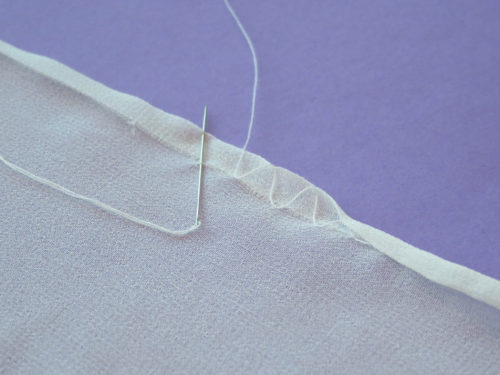
Pressing Concerns
Always be sure to press fabric by lifting the iron up and then putting it down on a new section of fabric, rather than pushing the iron up and down the length of a fabric. Iron on the reverse of the fabric with low, dry heat, using a clean ironing plate and press cloth. Pressing hard or ironing seams from the “right” side may leave permanent impressions in the fabric. Also, beware of water spots on delicate fabrics such as silk, as these can be difficult (or impossible) to remove.
Little Extras
Buttons and closures need to be lighter in weight for delicate fabrics otherwise they may drag or distort the garment. Choose good quality acrylic over glass for crystals and embellishments, as these will be lighter and therefore easier on the garment with wear. Ultra-lightweight zippers and delicate hook and eyes are also good options to consider. For the areas of the garment where closures are attached, use interfacing to reinforce these areas so as to prevent the delicate fashion fabric from ripping under stress.
Delicate fabrics may seem intimidating to sew with, these tips have you covered every step of the way. With a little planning and the right tools, you can make a dainty and beautiful garment that will be well worth the effort. So give yourself permission to reach for that delicate or sheer fabric that’s been calling your name!


